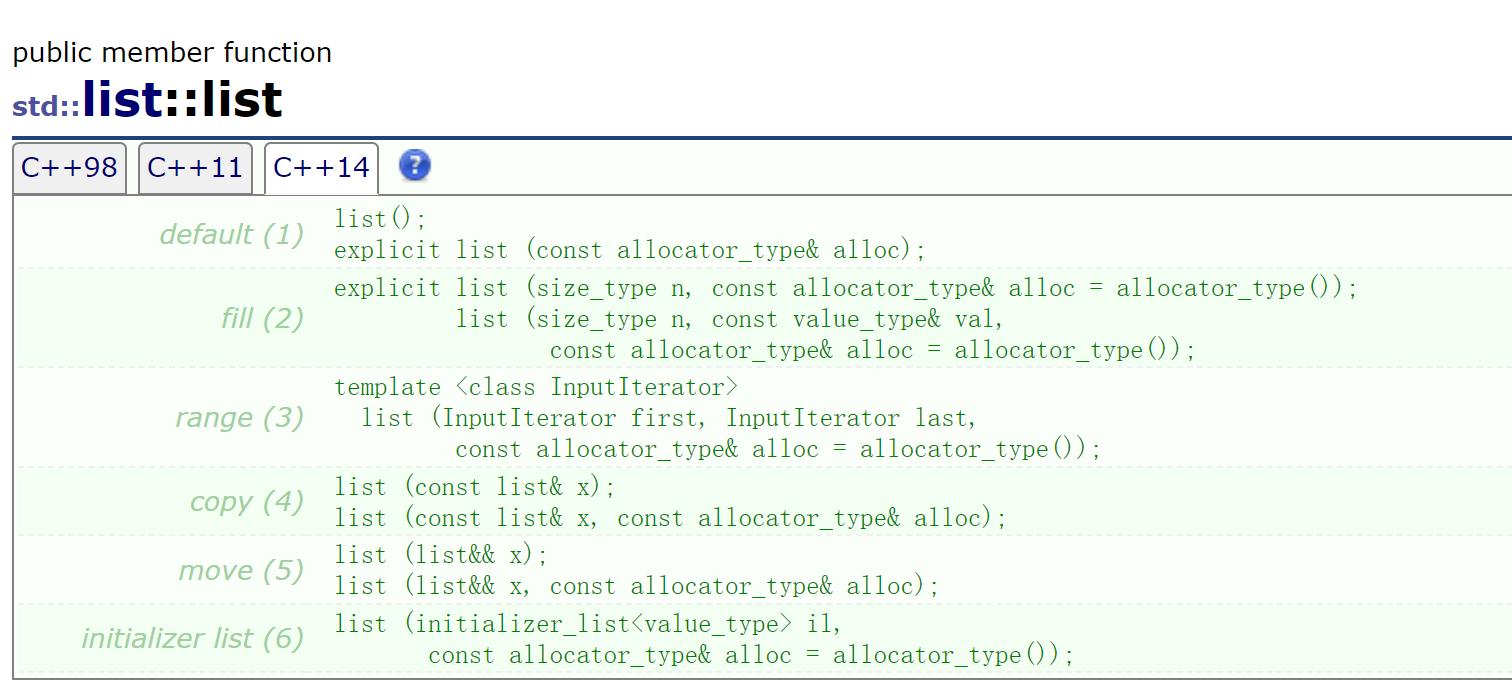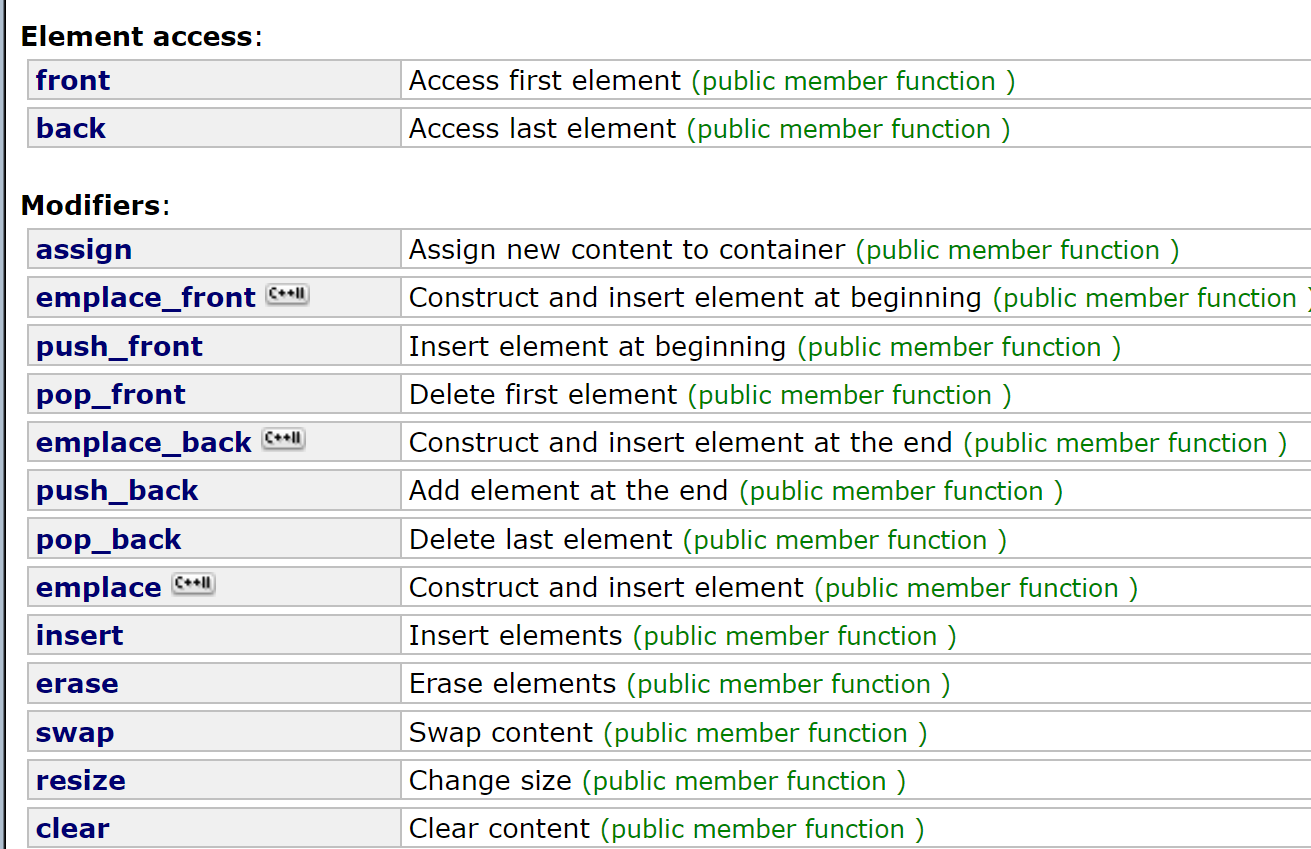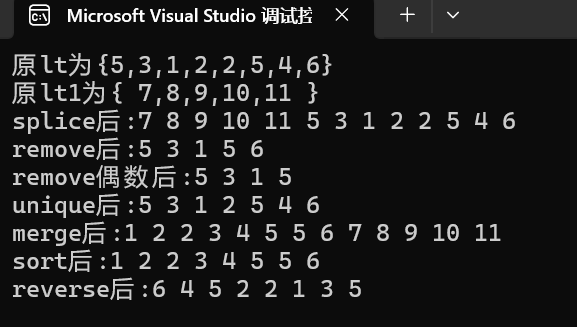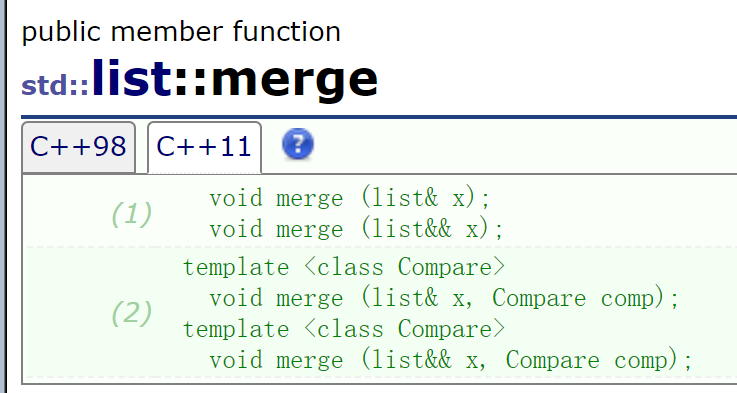C++STL系列之list
前言
这个是C语言中的带头双向循环链表,这么设计更方便头插尾插,end()迭代器指向头部,既然是带头双向循环链表,意味着每个结点都存放一个next和prev指针,通过头结点可以快速找到尾结点,任意位置插入都在常数时间内(得益于迭代器)。
如果熟悉C语言模拟的带头双向循环链表,list就会熟悉,list真正比较难的点在于迭代器和const迭代器,因为内部空间物理上不连续,逻辑上连续,无法像vector和string那样typedef T* iterator;这里留个悬念,后面讲。
一、list类以及常用接口和函数
官方文档
构造函数

和vector对比一下发现基本上一样,也没啥可说的了。
迭代器
既然是双向,就和vector的一样,普通,const,反向,const反向。
容量

和vector差别很大了,因为他是链表,无法提前扩容,也没有capacity一说。
重要函数

也和vector类似,vector没实现头插和头删因为效率太低(可以insert(begin())来哦头插),但是list的头插,头删,尾插,尾删效率非常高,其余接口没啥可说的。
操作

演示:
void Test_splice(list<int> lt,list<int> lt1)
{lt.splice(lt.begin(),lt1);cout << "splice后:";for (auto e : lt) {cout << e << ' ';}cout << endl;
}
void Test_remove(list<int> lt)
{lt.remove(2);lt.remove(4);cout << "remove后:";for (auto e : lt) {cout << e << ' ';}cout << endl;
}
void Test_remove_if(list<int> lt)
{lt.remove_if([](int a) {return a % 2 == 0; });cout << "remove偶数后:";for (auto e : lt) {cout << e << ' ';}cout << endl;
}
void Test_unique(list<int> lt)
{lt.unique();cout << "unique后:";for (auto e : lt) {cout << e << ' ';}cout << endl;
}
void Test_merge(list<int> lt,list<int> lt1)
{ lt.sort(), lt1.sort();lt.merge(lt1);cout << "merge后:";for (auto e : lt) {cout << e << ' ';}cout << endl;
}
void Test_sort(list<int> lt)
{lt.sort();cout << "sort后:";for (auto e : lt) {cout << e << ' ';}cout << endl;
}
void Test_reverse(list<int> lt)
{lt.reverse();cout << "reverse后:";for (auto e : lt) {cout << e << ' ';}cout << endl;
}int main()
{list<int> lt{5,3,1,2,2,5,4,6};list<int> lt1{ 7,8,9,10,11 };cout << "原lt为{5,3,1,2,2,5,4,6}" << endl;cout << "原lt1为{ 7,8,9,10,11 }" << endl;Test_splice(lt, lt1);Test_remove(lt);Test_remove_if(lt);Test_unique(lt);Test_merge(lt, lt1);Test_sort(lt);Test_reverse(lt);return 0;
}

用法用几次基本就会了,但是有几个需要注意的点:
1.splice

注意,如果传的是右值属性,或者传的拷贝,此时splice后,右值x被悬空,不能使用x。
2.merge

要求合并前两个list均有序。
3,sort
我问你,库里有一个sort,那这个sort还有用吗?当然,因为库里要求的是随机迭代器,list是双向迭代器。但是sort的意义不大,因为如果想要有序用list本身就不是一个明智的选择,list排序很麻烦,不如vector / set。
二、迭代器失效问题
insert
insert会失效吗?不会,因为insert不会涉及到开空间,只是把结点连接起来就可以,但是为了保持一致性,库里的insert同样返回的是新插入元素位置的迭代器。
erase
erase会失效吗?包的,你那个位置都没了当然失效了,所以erase会导致当然位置的迭代器失效,解决方法:返回值给原迭代器下一个迭代器的位置
三、list的模拟实现
list除了迭代器还是比较简单的,把_prev和_next链接好就可以,注意控制好_head
结点:
template<class T>
struct list_node
{T _val;list_node<T>* _next;list_node<T>* _prev;list_node(const T&x):_val(x),_next(nullptr),_prev(nullptr){}
};
list基本框架
还是加一个_sz来存储数据,这样求size()就可以快速拿到,否则还要遍历。
namespace myspace {template<class T>class list {typedef list_node<T> Node;public:list(){_head = new Node;_head->_prev = _head;_head->_next = _head;_sz = 0;}void push_back(const T& x){Node* newnode = new Node(x);Node* _tail = _head->_prev;_head->_prev = newnode;newnode->_next = _head;_tail->_next = newnode;newnode->_prev = _tail;_sz++;}private:Node* _head;size_t sz;};
}
当然,库里push_back还是复用的insert,所以我们来讲迭代器的实现。
普通迭代器
list的迭代器库里设计的很有意思,让我们一点一点讲下去。
首先想普通迭代器怎么设计? 直接使用T*一定不行,内存上不连续,使用不了,这里C++类里可以重载++,–,*的优势就来了,我们可以定义一个类,只分装一个结点指针,++就是让这个指针往next走,解引用就是拿到_node里的值,相等就是判断_node相不相等,begin就是iterator(_head->next)来构造。
大致写一个就是:
template<class T>
struct list_iterator
{typedef list_node<T> Node; typedef list_iterator<T> Self;Node* _node;list_iterator(Node* node):_node(node){}T& operator*(){return _node->_val;}Self& operator++()//前置加加{_node = _node->_next;return *this;}Self operator++(int)//后置加加{Self tmp(*this);_node = _node->_next;return tmp;}Self& operator--(){_node = _node->_prev;return *this;}Self operator--(int){Self tmp(*this);_node = _node->_prev;return tmp;}bool operator!=(const Self& x)const{return _node != x._node;}bool operator==(const Self& x)const{return _node == x._node;}T* operator->(){return &(operator*());}
};//list类里
typedef list_iterator<T> iterator;//迭代器
iterator begin()
{return iterator(_head->_next);
}
iterator end()
{return iterator(_head);
}
这里operator->的实现很有意思,当然可以直接对val取地址,这两个结果一样。
设一个Self是因为名字过长,这样比较方便。
这样遍历的代码就能跑起来了。
const迭代器
下一步:const迭代器怎么设计?先想一个问题,const迭代器是什么变成const属性?其实也就是operator* 和 operator->拿到的内容不能改变,有一种比较明显的思路,就是再分装一个类叫const_list_iterator去控制,当然这样是可以的,但是库里很杜绝这种非常冗余的行为,就是两份非常相似的代码不写一份而写两份,这块我们在set和map还会充分提现这个思想,库里怎么设计的呢?只能说真的很牛这个设计,它额外控制了两个模板参数来控制operator* 和operator->的返回值,在list里通过传const类型就是const迭代器,非const就是普通迭代器,
//list迭代器
template<class T,class Ref,class Ptr>
struct list_iterator
{typedef list_node<T> Node; typedef list_iterator<T, Ref, Ptr> Self;Node* _node;list_iterator(Node* node):_node(node){}Ref operator*(){return _node->_val;}Self& operator++()//前置加加{_node = _node->_next;return *this;}Self operator++(int)//后置加加{Self tmp(*this);_node = _node->_next;return tmp;}Self& operator--(){_node = _node->_prev;return *this;}Self operator--(int){Self tmp(*this);_node = _node->_prev;return tmp;}bool operator!=(const Self& x)const{return _node != x._node;}bool operator==(const Self& x)const{return _node == x._node;}Ptr operator->(){return &(operator*());}
};
list类内部:
typedef list_iterator<T, T&,T*> iterator;
typedef list_iterator<T, const T&,const T*> const_iterator;
这样设计就可以只用一份代码来实现const和非const迭代器,但是这里实际上还是两份代码,因为模板会编译出两份。
有了迭代器插入和删除就好写了,这也是为什么可以O(1)插入的原因。
insert
iterator insert(iterator pos, const T& x)
{Node* _node = pos._node;Node* _prev = pos._node->_prev;Node* newnode = new Node(x);_prev->_next = newnode;newnode->_prev = _prev;_node->_prev = newnode;newnode->_next = _node;_sz++;return iterator(newnode);
}
erase
iterator erase(iterator pos)
{assert(pos != end());Node* _prev = pos._node->_prev;Node* _next = pos._node->_next;_prev->_next = _next;_next->_prev = _prev;delete pos._node;_sz--;return iterator(_next);
}
其余头插头删和尾插尾删均可以复用erase和insert。
完善一下其他函数
构造
list(const initializer_list<T>& x)
{empty_init();auto it = x.begin();while (it != x.end()){push_back(*it);it++;}}
list(const myspace::list<T>& x)
{empty_init();auto it = x.begin();while (it != x.end()){push_back(*it);++it;}
}
private:
void empty_init()
{
_head = new Node;_head->_prev = _head;_head->_next = _head;_sz = 0;
}
重载operator=
void swap(list<T>& x)
{std::swap(_head, x._head);std::swap(_sz, x._sz);
}
myspace::list<T>& operator=(const myspace::list<T>& x)
{list<T> tmp(x);swap(tmp);return *this;
}
myspace::list<T>& operator=(myspace::list<T>&& x)
{swap(x);return *this;
}
析构
void clear()
{iterator it = begin();while (it != end()){it = erase(it);it++;}_sz = 0;
}
~list()
{clear();delete _head;_head = nullptr;
}
写clear和empty_init主要是为了方便,不写也可以。
完整模拟
个人gitee
四、list的优缺点
和vector相对:
优点就是插入和删除效率很高,适合频繁插入和删除的场景,也不涉及扩容问题
缺点:1.不支持随机访问,访问元素是O(n)
2.底层空间不连续,缓存效率低,空间利用率低
五、总结
list的迭代器需要掌握,后面的map和set还会用到类似的思想。
还需要掌握vector和list的区别,可以从底层,随机访问,插入删除,空间,迭代器等场景来做对比。
